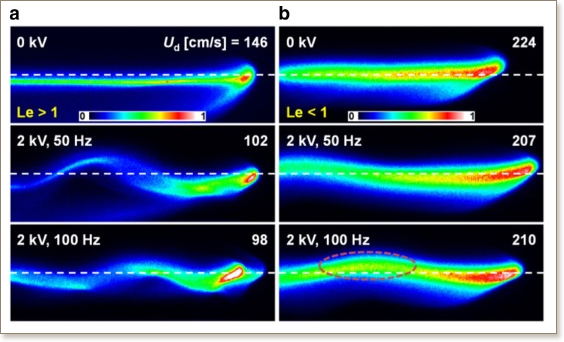

M.V. Tran, M.S. Cha
Proceedings of the Combustion Institute 36 (1),1421-1430 (2017)

The mechanism behind improved flame propagation speeds under electric fields is not yet fully understood. Although evidence supports that ion movements cause ionic wind, how this wind affects flame propagation has not been addressed. Here, we apply alternating current electric fields to a gap between the upper and lower parts of a counterflow, annular slot burner and present the characteristics of the propagating nonpremixed edge-flames produced. Contrary to many other previous studies, flame displacement speed decreased with applied AC voltage, and, depending on the applied AC frequency, the trailing flame body took on an oscillatory wavy motion. When flame displacement speeds were corrected using measured unburned flow velocities, we found no significant difference in flame propagation speeds, indicating no thermal or chemical effects by electric fields on the burning velocity. Thus, we conclude that the generation of bidirectional ionic wind is responsible for the impact of electric fields on flames and that an interaction between this bidirectional ionic wind and the flame parameters creates visible and/or measurable phenomenological effects. We also explain that the presence of trailing flame bodies is a dynamic response to an electric body force on a reaction zone, an area that can be considered to have a net positively charged volume. In addition, we characterize the wavy motion of the transient flame as a relaxation time independent of mixture strength, strain rate, and Lewis number.